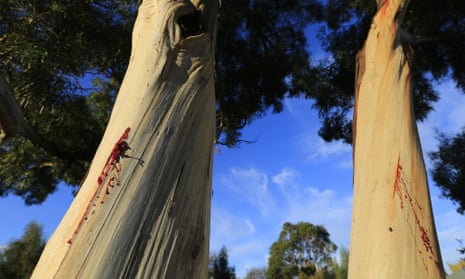If you’ve ever pondered what trees think about life’s major issues, the city of Melbourne has come up with an elegant solution – you can email them and find out.
The city council has devised an interactive urban forest map that provides individual data on each of the 70,000 trees that line the streets and parks of central Melbourne.
Each tree is assigned an identification number, which allows you to email it. Ostensibly this is to report damaged branches, but emailed expressions of tree devotion have been received from admirers.
Alas, the trees haven’t been tapping away at laptops with their twigs, asking email pests to leaf them alone. Instead a team at the city of Melbourne has branched out from other duties to field the emails.
“Some said we were wasting money, but the trees were always going to have individual ID numbers anyway,” said the appropriately named Arron Wood, a Melbourne city councillor.
“So it was only logical we’d assign the ID numbers to an email which connects these trees to the community.
“An unintended but positive consequence was that instead of reporting problems with trees, people began writing letters about how much they love individual trees in the city.
“The email interactions reveal the love Melburnians have for our trees. For example, one email came from workers who watered a tree outside the State Library so that the tree survived the drought.
“The emails show Melburnians know and respect the importance of trees in reducing heat in our city and increasing Melbourne’s liveability.”
One tree fan emailed their favourite golden elm telling it to keep up the good work, while a London plane tree was complimented on its beauty. A green leaf elm was urged to stay in good shape by a wellwisher moving abroad.
Melbourne’s urban forest strategy was initiated in 2007 in response to a 10-year drought that gripped much of southern Australia. The city aims to double the area covered by tree canopies by 2040 to soak up more carbon dioxide and reduce the “heat island” effect common in cities.
Eucalypts are the most common trees found in Melbourne, followed by plantanus and ulmus. Other species include ficus and acacia trees.
It is expected that Melbourne will lose more than four in 10 of its trees over the next 20 years due to old age. About 3,000 trees will need to be planted until 2040 to replace those trees and increase canopy cover.
Guardian Australia emailed a ginkgo maidenhair tree in Fitzroy Gardens, a park near Melbourne’s city centre, which responded: “Dear Oliver, Thank you for your lovely words. I am very well. Enjoy your day. Yours sincerely, Tree 1441724.”
A nearby ficus was also contacted for comment on the scheme but has yet to reply.

Comments (…)
Sign in or create your Guardian account to join the discussion